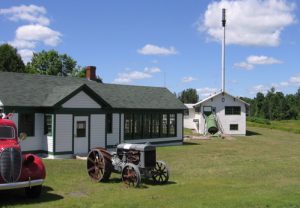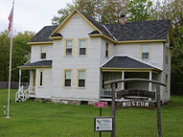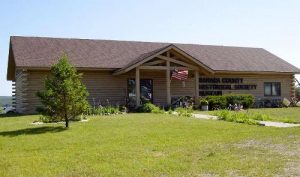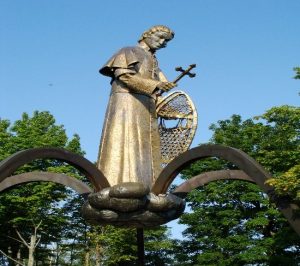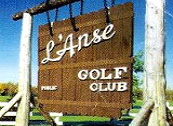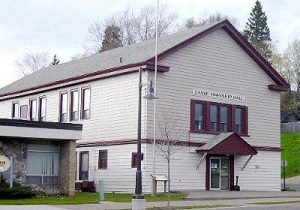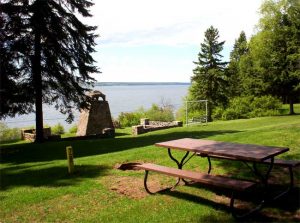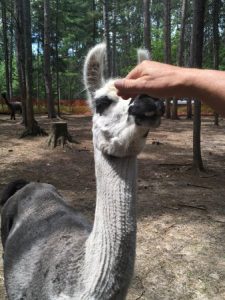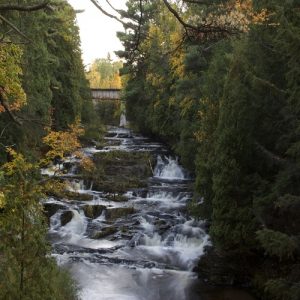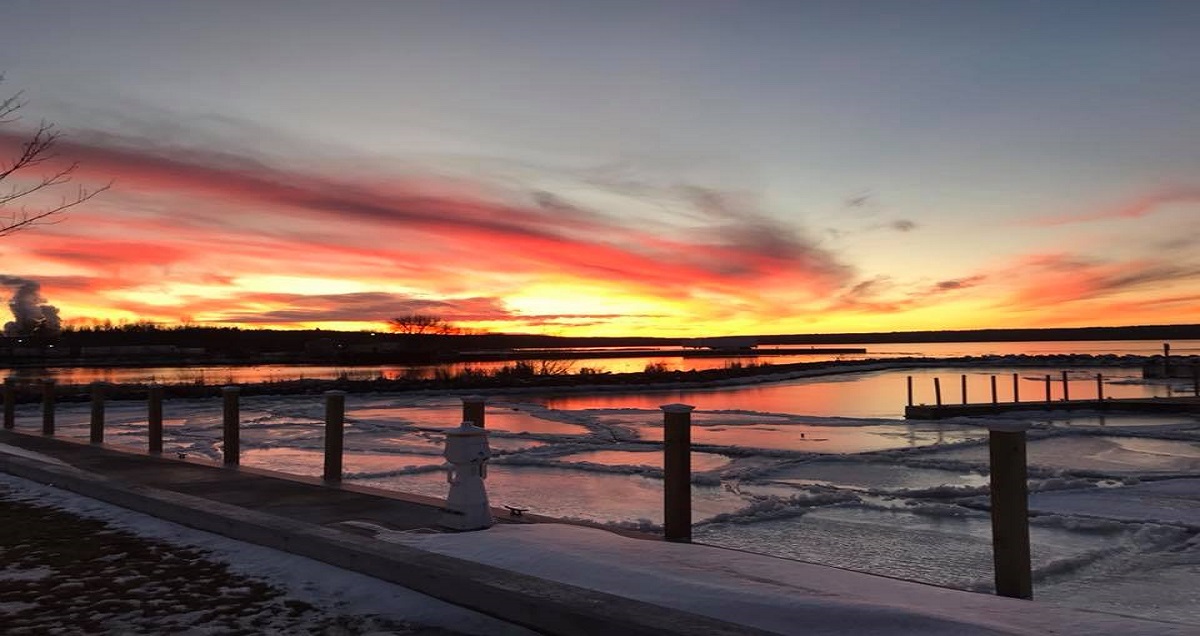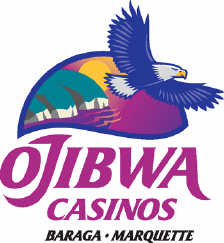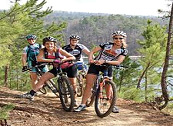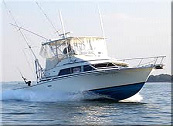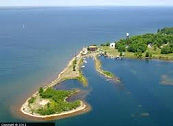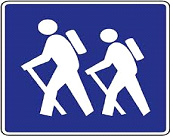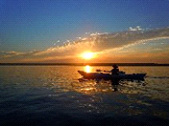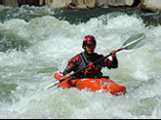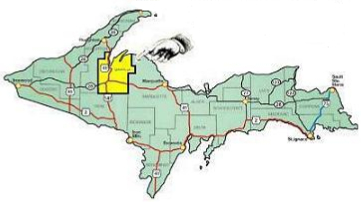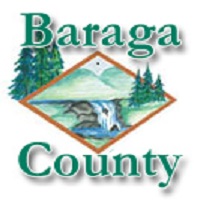History of Baraga County - This brief history of Baraga County is really a fun challenge for me to write.
I have to make a decision as to when I should begin the history.
For this page, I have selected to begin with the admission of Michigan as a State to the Union in 1837.
Please note, this is not intended to imply no important history occurred in our county before this date.
The serious or amature historian can research the historic Sand Pointe burial mound reports and learn how the woodland tribes were here over a 1000 years ago.You can read about Fr.
Menard visiting and spending the winter of 1660-61 here in Baraga County and of course the American Fur Trade center at Assinins.
For me, I will leave many of those items to be discussed on your visits to the museum or for you to research.
Our history as a county was decided by the “Toledo War” and the awarding of that territory to Ohio with the State of Michigan given the entire Upper Peninsula (UP), lands originally belonging to Wisconsin. In 1837, there were six UP counties with Baraga being a part of Ontonagon County.
In 1846, Houghton County was created out of Ontonagon County encompassing Baraga, Keweenaw and present Houghton Counties.
In 1875, the state legislature approved the formation of Baraga County, with the county seat to be in L’Anse.
The Houghton County Board of Supervisors at its annual meeting in October of 1875 voted to separate lands from itself to form Baraga County.
Baraga County was divided into five townships which include, Arvon, Baraga, Covington, L’Anse and Spurr.
Each of these townships has a history of its own with important persons establishing schools, churches, businesses and other social and recreational activities.
Each of these townships have influenced the county’s general history, along with the Indian Treaties, one being the Treaty of LaPointe in 1842.
This Treaty stated that the federal government would send a blacksmith,
farmer, and carpenter that were to assist and train the Indians in these important skills.
These three families were the Brockways, Carriers and Johnsons with the task of training the locals in the above mentioned skills.
part of Houghton County
Not unlike today the early days of the county, even while still a part of Houghton County, were influenced by religion.
The Methodist were the first to have a permanent mission following Menard’s visit of 1660.
Part of it being that the Brockway brother William, was the Methodist chaplain at Fort Brady, Sault Ste. Marie.
He recommended his brother Daniel to be the blacksmith in L’Anse. When Father Frederic Baraga arrived in 1843 at the request of Pierre Crebassa and remained in the area establishing a Catholic Mission a war of words began.
The circular issued by Robert Stuart, Michigan Superintendent of Indian Affairs, simply said that the region belonged to the first religious group that was there first.
That of course would favor the Methodist, but Baraga addressed the issue head on and was able to obtain a decision permitting his mission to continue.
The Catholic Mission was at Assinins, West Side and the Methodist was at Zeba, East Side as the entire area was still known as L’Anse East or West.
Today, both locations have small congregations with the members attending services in L’Anse or Baraga.
Brockway himself fell into disfavor as he was an enterprising business person and raised large crops to be sold to the copper mining settlements.
He left L’Anse in 1846 and opened a public house in Copper Harbor, Michigan.
The Railroad played another important role in the development of the county.
L’Anse was being seen as a primary competitor for the shipment of ore replacing Marquette and Escanaba.
This optimism was running high in the early 1870s but the Panic of 1873 saw what was going to be the primary port disappear.
However the completion of the Marquette, Houghton and Ontonagon Railroad connecting L’Anse to the “outside world” in 1872 saw the boom continue.
Buildings were floated on barges from the Copper Country as enough lumber for building was not available to meet the demands.
L’Anse was the place investors were coming to, it was the location that businesses were coming to, it was to be the port of Superior.
L’Anse also boasted as having the largest cargo dock in the world.
But as mentioned before, the Panic of 1873 saw an almost death blow to the community.
The ore docks shipped little ore and sat idle, later to be destroyed in the fire of 1896.
failed to construct a 42-mile railroad track
L’Anse was not alone in the county to grow with the railroads.
The biggest fiasco being that of the Iron Range and Huron Bay Railroad.
This was a plan to make a 42 mile railroad from Champion to Huron Bay.
The organizer, Milo Davis, undertook a two million dollar fiasco that never saw a single railroad engine run on the track! He was able to convince developers that it could be done and they continued to support him with money.
Building a major dock on Huron Bay, the engines were unloaded at the dock and on the first attempt at making a trip over the track, it toppled into the ditch.
Davis left for Mexico and the lines were pulled up, the dock dismantled and the engines sold to a company in Canada.
Another community that “grew” with the railroad was Keweenaw Bay, and what was to be a future settlement called Michigan, Michigan.
From the Mineral Range Railroad, copper was to be shipped by rail from Mass City to the mills that were built in Keweenaw Bay.
This effort also ended and most of the buildings were removed. But the railroad did come to Baraga and in 1891 the village was incorporated and separated from township government.
Mining in Baraga County was never going to make many folks rich.
The slate mines in Arvon, the Taylor mine in Bovine, the sandstone harvesting in Arnheim were all short lived.
The county would earn it’s real place in history with one of its greatest natural resource, the forests.
Captain James Bendry had mills in L’Anse and Baraga as did many other operators I will introduce only a couple of others that had a major impact.
The Hebard’s of Pequaming, built a community for their employees, modeling it after the townsites of New England.
The Hebard’s recognized Pequaming as a natural harbor on the bay and took advantage of this location to have a successful lumber operation.
Across the bay in Baraga
Across the bay in Baraga, the Nester’s purchased the local mill and expanded it to successfully cut millions of feet of lumber annually.
The Nesters also built large 150-200 foot vessels, bringing shipbuilders with them from Saginaw.
Their arrival in 1886 saw the township of Baraga being the largest in populations as the mill employed many men, and the steam from the mill heated most of the community.
The next major player was Henry Ford as he purchased both the Pequaming Mill and the L’Anse Mill.
He later built a model mill and community south of L’Anse called Alberta.
Ford also purchased mills in Big Bay and the Iron Mountain/Kingsford area.
The wood from Ford’s mills were used in the manufacturing of his automobiles.
Today, The Celotex Corporation which is located in L’Anse, is a manufaturer of ceiling tile and particle board.
This company also uses the forest resources.
The company was recently sold to a British firm and is continuing it’s operations in L’Anse.
The Pettibone Cary-lift was an invention by a Baraga County man named Phil LaTendresse.
Located in Baraga, Pettibone employes many people both in the main shop and in other sub-contracting shops, building parts for this world renown machine.
I have tried to give you a brief overview of Baraga County’s history which is rich and well documented.
There are many historic events that I passed over or others mentioned briefly.
It’s not that those events or those people were not important, but that I have interested you a little to learn more about the county.
Remember, it is not every county that can claim a national ambassador under John F.
Kennedy is buried within its borders.
Not every county can claim that its county seat was destroyed by fire but was able to rebuild. Not another county can claim that Native American gaming started here.
Brief as it is, my hope is it’s only a beginning for you.
History credit and information comes from:
Jim Dompier, President Baraga County Historical Society
…
